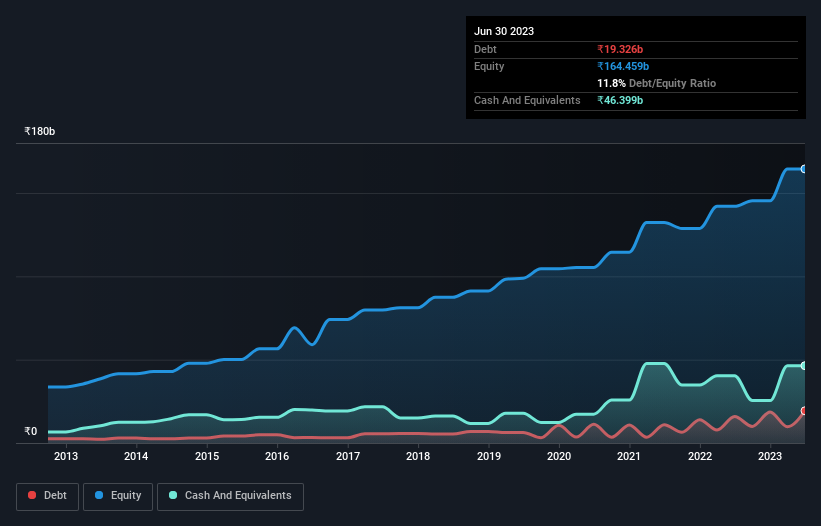
The external fund manager backed by Berkshire Hathaway's Charlie Munger, Li Lu, makes no bones about it when he says 'The biggest investment risk is not the volatility of prices, but whether you will suffer a permanent loss of capital.' When we think about how risky a company is, we always like to look at its use of debt, since debt overload can lead to ruin. As with many other companies Asian Paints Limited (NSE:ASIANPAINT) makes use of debt. But the more important question is: how much risk is that debt creating?
When Is Debt A Problem?
Debt and other liabilities become risky for a business when it cannot easily fulfill those obligations, either with free cash flow or by raising capital at an attractive price. In the worst case scenario, a company can go bankrupt if it cannot pay its creditors. While that is not too common, we often do see indebted companies permanently diluting shareholders because lenders force them to raise capital at a distressed price. By replacing dilution, though, debt can be an extremely good tool for businesses that need capital to invest in growth at high rates of return. When we think about a company's use of debt, we first look at cash and debt together.
View our latest analysis for Asian Paints
What Is Asian Paints's Debt?
You can click the graphic below for the historical numbers, but it shows that as of March 2023 Asian Paints had ₹19.3b of debt, an increase on ₹15.9b, over one year. But on the other hand it also has ₹46.4b in cash, leading to a ₹27.1b net cash position.

A Look At Asian Paints' Liabilities
The latest balance sheet data shows that Asian Paints had liabilities of ₹79.0b due within a year, and liabilities of ₹14.6b falling due after that. On the other hand, it had cash of ₹46.4b and ₹50.6b worth of receivables due within a year. So it actually has ₹3.51b more liquid assets than total liabilities.
This state of affairs indicates that Asian Paints' balance sheet looks quite solid, as its total liabilities are just about equal to its liquid assets. So while it's hard to imagine that the ₹3.11t company is struggling for cash, we still think it's worth monitoring its balance sheet. Succinctly put, Asian Paints boasts net cash, so it's fair to say it does not have a heavy debt load!
On top of that, Asian Paints grew its EBIT by 31% over the last twelve months, and that growth will make it easier to handle its debt. There's no doubt that we learn most about debt from the balance sheet. But it is future earnings, more than anything, that will determine Asian Paints's ability to maintain a healthy balance sheet going forward. So if you're focused on the future you can check out this free report showing analyst profit forecasts.
Finally, a company can only pay off debt with cold hard cash, not accounting profits. While Asian Paints has net cash on its balance sheet, it's still worth taking a look at its ability to convert earnings before interest and tax (EBIT) to free cash flow, to help us understand how quickly it is building (or eroding) that cash balance. In the last three years, Asian Paints's free cash flow amounted to 44% of its EBIT, less than we'd expect. That's not great, when it comes to paying down debt.
Summing Up
While it is always sensible to investigate a company's debt, in this case Asian Paints has ₹27.1b in net cash and a decent-looking balance sheet. And it impressed us with its EBIT growth of 31% over the last year. So we don't think Asian Paints's use of debt is risky. Over time, share prices tend to follow earnings per share, so if you're interested in Asian Paints, you may well want to click here to check an interactive graph of its earnings per share history.
If, after all that, you're more interested in a fast growing company with a rock-solid balance sheet, then check out our list of net cash growth stocks without delay.
New: Manage All Your Stock Portfolios in One Place
We've created the ultimate portfolio companion for stock investors, and it's free.
• Connect an unlimited number of Portfolios and see your total in one currency
• Be alerted to new Warning Signs or Risks via email or mobile
• Track the Fair Value of your stocks
Have feedback on this article? Concerned about the content? Get in touch with us directly. Alternatively, email editorial-team (at) simplywallst.com.
This article by Simply Wall St is general in nature. We provide commentary based on historical data and analyst forecasts only using an unbiased methodology and our articles are not intended to be financial advice. It does not constitute a recommendation to buy or sell any stock, and does not take account of your objectives, or your financial situation. We aim to bring you long-term focused analysis driven by fundamental data. Note that our analysis may not factor in the latest price-sensitive company announcements or qualitative material. Simply Wall St has no position in any stocks mentioned.
About NSEI:ASIANPAINT
Asian Paints
Engages in the manufacturing, selling, and distribution of paints, coatings, and products related to home decoration and bath fittings in Asia, the Middle East, Africa, and the South Pacific region.
Excellent balance sheet established dividend payer.


